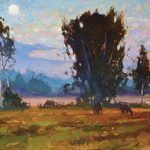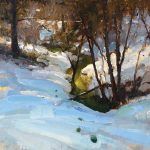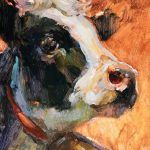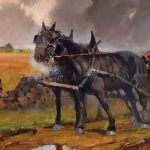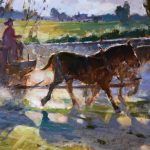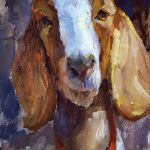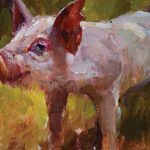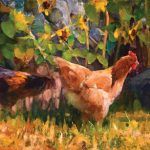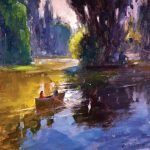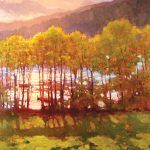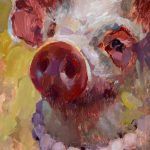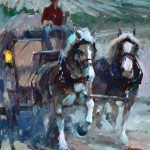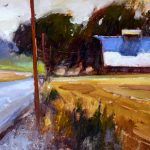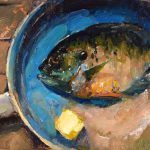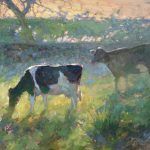Kyle Paliotto’s paintings reflect his romantic view of nature and rural life
By Gussie Fauntleroy
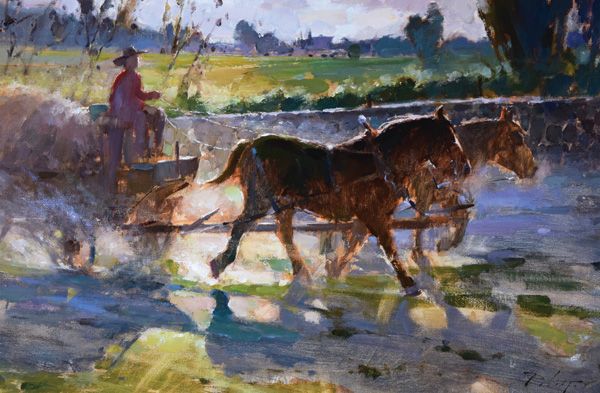
Kyle Paliotto, Morning Thunder, oil, 20 x 30.
This story was featured in the January 2017 issue of Southwest Art magazine. Get the Southwest Art January 2017 print issue or digital download now–then subscribe to Southwest Art and never miss another story.
When Kyle Paliotto paints a pair of strong, handsome draft horses trotting with ease as they pull a wooden hay wagon on a puddled farm road, he’s actually expressing something about human nature. The horses, often sturdy breeds like those in the northern Idaho farm country where Paliotto lives, are doing what they are bred to do—moving through the world in the moment, feeling the fresh air, muscles working, water splashing up. For the artist, a painting such as MORNING THUNDER speaks not only of a quieter time when humans and the natural world were more in harmony. It also reflects his appreciation for the sense of contentment and rightness that comes when animals—or people—are fulfilling their life’s purpose.
At 42 and in his 10th year as a full-time artist, Paliotto sees himself a bit like the steadfast, hardworking farm animals he paints. Having achieved a level of technical proficiency and gained his stride in the daily undertaking of an artistic career, he finds himself relaxing into the process, enjoying both plein-air sketching and studio work. And the award-winning results are finding their way to a growing number of viewers and collectors who appreciate his expressive rendering of the landscape and rural life.
Some of Paliotto’s fondest boyhood memories involve time spent outdoors in farm country on the outskirts of Cleveland, OH, where his father was a pastor. At the time he didn’t think of his family as unusually artistic, but it was clearly in the genes. His mother was gifted at drawing portraits, his father possessed latent artistic talent that emerged later in life, and Kyle and his brother and sister all played musical instruments. Paliotto remembers asking his mother to draw him a parrot when he was about 5. “I would watch her draw people, and it would be awesome to see faces come alive,” he says. “I wanted a parrot badly, but she told me to draw it.” So he did, and he continued to draw throughout his school years, earning attention and awards for his skill.
As a hands-on learner, however, Pal-iotto didn’t find as much enjoyment in academics. Making things more difficult were numerous family moves for his father’s work, including six schools in six years—in Cleveland, Los Angeles, San Diego, and back to Ohio. After his junior year Paliotto dropped out and earned a high school diploma through night school. He also earned a scholarship to the Cleveland Institute of Art. But the toll of frequent life disruptions was paid with alcohol and drug involvement, and he lost the scholarship. It felt like a major setback at the time, yet he now knows the experience strengthened him. “This is what makes me who I am as an artist,” he says.
- Kyle Paliotto, After Dinner Walk, oil, 16 x 20.
- Kyle Paliotto, Cow Bell, oil, 7 x 6.
- Kyle Paliotto, In All Weather, oil, 24 x 30.
- Kyle Paliotto, Morning Thunder, oil, 20 x 30.
- Kyle Paliotto, Old Faithful, oil, 13 x 9.
Clean and sober by 18, Paliotto moved back to the San Diego area to study art at Palomar Community College. At a time when the comic-book industry was creating a market for highly trained illustrators, Palomar offered a strong program of classical art instruction established by acclaimed painter John Asaro. (Years later, Paliotto had the privilege of showing his work next to Asaro’s at Saks Galleries in Denver.) Along with providing a solid foundational training, Palomar reinforced Paliotto’s love of art, in particular through the enthusiastic influence of painting professor Doug D.G. Durrant.
After living for a brief period in Mexico City, learning the language and absorbing the country’s vibrant color and life, Paliotto returned to California. He worked in commercial art for seven years, honing his self-discipline, openness to constructive criticism, and entrepreneurial skills. He also married, and when his father-in-law decided to explore retirement possibilities in northern Idaho, Paliotto went along, perceiving an opportunity to open the door to his true passion. In 2005 he and his wife, Rebecca, settled just north of Coeur d’Alene. (Her parents and siblings now also live there.) The move brought Paliotto in contact with painter and art dealer Timothy Thies, who became a mentor and remained a friend until his passing a few years later. In Idaho, surrounded by farmland, aging barns, and the lovely northern landscape, and encouraged by family and artist friends, Paliotto found the environment he needed to shift into full-time fine art.
“Looking back at myself at 30, I was not prepared for how much work a fine-art career would be,” the painter says, smiling as he sits in a wooden rocking chair in the detached garage he converted into a studio next to his house. Warmed by a woodstove, the compact space contains a painting area, a desk and computer for the business end of art, frame-making equipment, a space for packing and crating his work, and room for weekly classes in which he teaches a dozen or so local students. There’s also a worktable where Paliotto sculpts clay. The sculpting is for fun, but it provides benefits back at the easel as well. “When you’re sculpting you have to see a three-dimensional form with your hands, so when I go to paint or draw, it’s so much easier because of what my hands have done,” he says.
Also in the studio is a baby grand piano, where the artist’s hands periodically explore another type of expression. He’s just learning to play but is intrigued by the parallels between piano keys and brush strokes—both can communicate through an immense range of rhythm, tempo, and emotional tone. “Piano has done more for my painting than painting has done for my piano,” he says. Still, music is an important part of his life, and the musical analogy returns as he reflects on gathering inspiration for paintings—which happens virtually everywhere he goes. “It’s like a composer who walks through the countryside and then comes back and composes music,” he says.
- Kyle Paliotto, One Fine Pig, oil, 9 x 12.
- Kyle Paliotto, Summer Gals, oil, 18 x 36.
- Kyle Paliotto, The Boaters, oil, 20 x 20.
- Kyle Paliotto, Water Music, oil, 36 x 36.
- Kyle Paliotto, Dinner Party, oil, 8 x 6.
Paliotto’s visual compositions generally begin outdoors with sketches and photographs. Back in the studio these become reference for the imaginative play of his mind and hands in a romanticized view of rural life. “When I paint, I truly want to paint humanity: the romance, the struggle, the honesty, the adventure,” he says. “When I look at animals I see those human qualities—it’s a universal way to express that. I’m a representational artist, so all those emotions need to have some vehicle, and my love for animals gets me there.”
Although his focus is representational imagery, Paliotto aims for an expressive, impressionistic style. He believes he can say more with fewer brush strokes than by means of the intensely realistic approach he practiced as a youth. In much of his work he also offers another definition of realism, combining imagery components to construct an idealized scene. “The thing about these paintings is, they’re my reality,” he says. “It might be easier to copy a perfect photo, but with this I feel like I’ve accomplished more because I’m not trying to paint reality, I’m trying to create reality.” It’s a reality in which meaning resides in symbols of honest work, the beauty of the divinely created earth, and human connections.
One important connection that blossomed as a result of Paliotto’s art career is with his father. Once when George Paliotto traveled from Los Angeles to visit his son, the two were in the younger man’s studio as he was working. George, with inherent talent but no formal art training at the time, began offering advice on his son’s painting. “So I gave him the brush and said, ‘Dad, you put it in.’ He grabbed the brush and started painting,” Paliotto remembers. The following day Paliotto asked his father if he’d like to paint something. George began a landscape, but eventually became frustrated. “So I finished his painting and he finished mine,” Paliotto says. Today George Paliotto is a western artist working in watercolors and oils, and father and son talk often on the phone about painting. Their relationship is closer than they could have imagined had it not been for art.
- Kyle Paliotto, Green Bluff, oil, 8 x 16.
- Kyle Paliotto, Keep Fighting, oil, 9 x 12.
- Kyle Paliotto, Mourning Hope, oil, 22 x 28.
Paliotto’s own children influence his artistic life as well. He describes his studio as “insulated but not isolated” from the energy of a 6-year-old daughter and 8-year-old son. One of his favorite activities, fishing with his son, has resulted in richly hued renderings of his son’s catch. In recent years Paliotto has also been exploring figurative painting, including portraits of Masai and Hadza villagers he met on trips to the East African country of Tanzania. A departure from his usual subject matter, the portraits are another way of expressing his Christian faith and his love for people and the natural world. “When I paint, what I’m trying to do is express what God has made, in the most beautiful way possible,” he reflects. “I’m trying to get my emotions to go through a painting and into someone’s heart. Now, at this point in my career, I’m confident with my skill set and what I want to say. It’s like a new chapter has opened to the first page, and now I just get to enjoy it.”
representation
Christopher Queen Galleries, Duncans Mills, CA; Paderewski Fine Art, Beaver Creek, CO; Saks Galleries, Denver, CO; The Art Spirit Gallery, Coeur d’Alene, ID.
This story was featured in the January 2017 issue of Southwest Art magazine. Get the Southwest Art January 2017 print issue or digital download now–then subscribe to Southwest Art and never miss another story.
MORE RESOURCES FOR ART COLLECTORS & ENTHUSIASTS
• Subscribe to Southwest Art magazine
• Learn how to paint & how to draw with downloads, books, videos & more from North Light Shop
• Sign up for your Southwest Art email newsletter & download a FREE ebook






